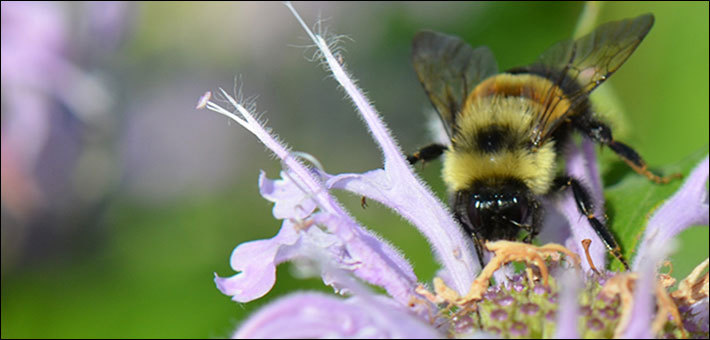Pollinating insect populations are declining worldwide. Revegetating roadsides after construction offers an opportunity to create pollinator-friendly habitat. Local agencies and MnDOT have new tools and strategies to cost-effectively derive multiple benefits from roadside revegetation efforts.
Plant-pollinating insects are essential for the survival of most flowering plants. Sustaining pollinators may also enhance the pollination of nearby crops and support other beneficial insects, such as those that prey on agricultural pests. However, pollinator populations around the world are declining, largely due to habitat loss. The rusty patched bumble bee, for example, has been listed as an endangered species, and the monarch butterfly is waitlisted by the U.S. Fish and Wildlife Service (USFWS) to be listed as threatened.
Transportation projects generally include revegetation along the roadsides where there is significant potential to include plant species that support pollinator communities. Healthy and diverse vegetation bordering the roads also provides necessary soil stabilization and visual appeal. Additionally, planting pollinator-friendly vegetation may support compliance with federal requirements to create or safeguard the habitat of endangered species.
“This project will help agencies across the state refine the seed mixes they use with substantial benefits to pollinator habitat as well as cost savings,” said Dan MacSwain, natural resource coordinator, Washington County Public Works.
The Local Road Research Board and MnDOT recognized this potential but there has been little evaluation of the plant types that grow well and support pollinators. Few efforts have mapped the extent and location of bumble bee or butterfly habitat. The agencies needed to know how and where to focus revegetation efforts to maximize limited resources and optimize the placement of pollinator habitats.
What Was Our Goal?
The goal of this research was to identify cost-effective roadside revegetation methods and locations to benefit pollinators, including bumble bees and butterflies.
What Did We Do?
To identify locations where pollinator-friendly habitats would be most beneficial, researchers devised a two-part study to explore the relationship between roadside vegetation and the presence of bumble bees and butterflies.
First, they surveyed the presence of bumble bees and flowering vegetation in over 35 roadside locations near previously mapped areas of landscape beneficial to a range of pollinators in Washington County. This data was used to determine the utility of pollinator- and bumble bee-friendly habitat designations.

Then they examined the bumble bee and butterfly populations in 57 revegetated areas from 19 construction projects conducted over the past two decades. Researchers visited each site six times over 2.5 months and compared areas seeded with native mixes, sites seeded with nonnative mixes and nearby typical sites as an additional control to determine any differences in vegetation types and pollinator populations and foraging patterns. The age range of the vegetated sites allowed researchers to observe how different vegetative communities change over time.
What Did We Learn?
Extensive fieldwork and analysis of previous research led researchers to several general conclusions and recommended management strategies related to floral cover, native and nonnative plant species, and roadside vegetation maintenance:
- Floral cover. An abundance and diversity of flowers and proximity to other pollinator habitat draw more abundant and diverse bumble bees and butterflies. Seed mixes for revegetation should contain an assortment of flowering herbaceous plants. While diverse native mixes are more expensive than those with more homogenous nonnative plants, commonly used grass seed can be amended with flowering forbs that establish well and pollinators prefer, such as wild bergamot, milkweed and goldenrod.
Nonnative flowering plants popular with pollinators include alfalfa and clovers. Nonnative mixes, however, should be streamlined to reduce the species that don’t establish well.
- Native and nonnative plant species. Bumble bees and butterflies are considered generalist pollinators since they forage on a range of plant species. Investigators unexpectedly found that native flowers do not attract a greater diversity of bumble bees and butterflies than nonnative flowers. However, research has established that specialist pollinators—those that gather pollen from only a few specific plants—depend on native forbs. Additionally, the monarch butterfly will only lay its eggs on native milkweed. Native plants, many of which have deeper root systems than many nonnatives, also stabilize soil along roadsides and filter stormwater.
“This work gives local agencies and MnDOT specific management direction for their chosen revegetation strategies. If restoring more native vegetation is the goal, they will need to proactively plant those seeds and tailor maintenance activities to sustain them,” Emilie Snell-Rood, associate professor and associate department head, University of Minnesota Department of Ecology, Evolution and Behavior.
- Roadside vegetation maintenance. Overall, roadside revegetation efforts should focus on establishing and maintaining diverse flowering plants. Habitat mapping can help prioritize areas to plant pollinator-friendly vegetation and could be continually refined to identify species-specific habitat.
As the abundance of native plants tends to be dominated over time by nonnative grasses, maintaining native roadside vegetation will require active interventions such as mowing, nitrogen reduction or selective herbicide treatment. Finally, record-keeping during planting and continued monitoring will help identify successful strategies for pollinator-friendly vegetation.
What’s Next?
Local agencies and MnDOT can begin using the information on cost-effective, pollinator-friendly seed mixes for revegetation and habitat mapping immediately. Going forward, agencies will need to determine the desired extent of native vegetation planting and appropriate maintenance routines for seed mixes chosen to encourage and sustain the intended pollinator-friendly vegetation.


Upon reading this news, I just wanted to extend a hearty thank-you on behalf of Manitoba, and our monarch butterfly Facebook group “Manitoba Monarchs”, a community of over 2,100 enthusiasts in our province who are invested in the species and its welfare. Many of our summer visitors travel through MN during the migration and we’re most appreciative of this initiative!